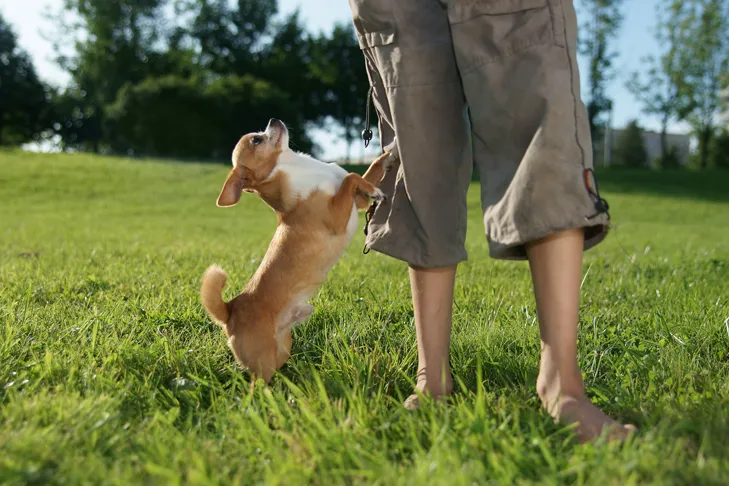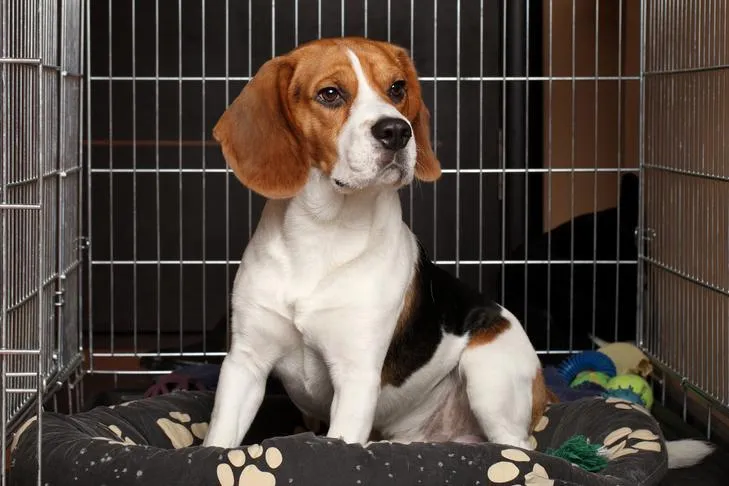Jumping up on people is a natural canine behavior, often stemming from a dog’s instinct to greet face-to-face and seek attention. While it might seem like an innocent gesture, this habit can be annoying and potentially dangerous, leading to muddy paw prints on clothes or even knocking over children and seniors. For these reasons, learning how to Train Puppy Not To Jump On People is crucial for fostering a well-mannered companion and ensuring safer, more polite interactions. This guide will provide you with effective strategies to teach your dog appropriate greeting behaviors, ensuring they greet guests with all four paws on the floor. A well-behaved puppy is a joy, and foundational training like this goes hand-in-hand with other essential skills, such as how to properly potty train a puppy.
Why Dogs Jump and How to Stop It
Dogs are creatures of habit, and they tend to repeat behaviors that earn them rewards. When a dog jumps up to greet someone, they often receive immediate attention, which serves as a powerful reward. This attention can come from family members, visitors, or even strangers. Crucially, even negative reactions, like yelling or pushing them away, can be perceived as a form of attention, thus reinforcing the jumping behavior. For many dogs, a push-away can simply become part of an exciting “wrestling game,” further encouraging the unwanted action.
To effectively eliminate jumping from your dog’s greeting repertoire, you must remove these associated rewards. This involves actively managing your dog’s environment and interactions to prevent them from practicing the jumping behavior, while simultaneously teaching them a more appropriate and polite way to greet people. Consistency from everyone interacting with your dog is key to breaking this ingrained habit and establishing new, desirable behaviors.
 Small dog excitedly jumping up on a person's leg
Small dog excitedly jumping up on a person's leg
Teaching Alternative Greeting Behaviors
While simply ignoring your dog when they jump might theoretically lead to the behavior stopping, this approach can be frustrating for your dog and impractical in real-world situations, as not every person your dog encounters will follow the “ignore” rule. Instead, it’s far more effective to actively teach your dog what to do instead of just what not to do. The specific alternative greeting behavior you choose is flexible; you might prefer your dog to simply keep all four paws on the floor, or you might prefer them to sit or even lie down when greeting. The goal is to provide a clear, positive instruction that replaces the jumping.
How to Train “Four on the Floor”
Teaching your dog to keep all four paws on the floor during greetings is an excellent alternative to jumping. This method focuses on preventing the jump by rewarding your dog before they even have the chance to leave the ground. The core idea is to associate keeping their feet on the ground with positive outcomes.
Follow these steps to teach the “four on the floor” greeting:
- Preparation: Put your dog on a leash and have a friend or family member approach them.
- Anticipate and Reward: Before the person reaches your dog, quickly toss several treats on the floor.
- Positive Reinforcement: While your dog is focused on eating the treats from the floor, have the person calmly pet and greet them.
- Manage Duration: Before your dog finishes eating, have the person step back and walk away.
- Repetition and Extension: After several repetitions, repeat the steps, but this time, extend the greeting, continuously tossing treats on the floor as long as the person is interacting with your dog.
- Gradual Reduction: Once your dog consistently keeps all four feet on the ground, allow them to greet the person before you place the first treat.
- Fading Treats: As your dog’s understanding grows, gradually reduce the number of treats until the greeting and attention itself become the primary reward.
The key to success with this technique is anticipating your dog’s jumping behavior and providing the treats quickly, before the jump occurs. If you’re too slow and your dog jumps, immediately have the person turn and walk away, and stop feeding treats. Your dog will quickly learn that keeping all four paws on the floor earns positive attention and treats, while jumping results in the loss of both.
 Bull Terrier puppy sitting attentively in a green yard, looking upwards
Bull Terrier puppy sitting attentively in a green yard, looking upwards
How to Train “Sit” for Greetings
Another highly effective and polite greeting behavior is teaching your dog to sit when interacting with people. Similar to the “four on the floor” method, this training teaches your dog that a sitting position brings attention, while standing up causes the attention to cease. This clear consequence helps your dog understand the desired behavior.
Here are the steps to train “sit” for greetings:
- Stationary Setup: Tether your dog’s leash to a doorknob or a sturdy piece of furniture, ensuring they cannot jump on you.
- Initial Practice: From a few feet away, ask your dog to sit. When they comply, calmly approach them. If they stand up, immediately turn and walk back to your starting point and ask for the sit command again.
- Reinforce Sitting: If they remain sitting, approach, calmly praise, and gently pet them. Continue greeting them as long as they stay seated. The moment they stand up, turn and walk away, ending the interaction.
- Increase Excitement: As your dog masters sitting for greetings with you, gradually make your approaches more engaging and exciting.
- Generalization: Once your dog reliably sits for your greetings, repeat these steps with friends and other family members to generalize the behavior.
Remember, consistent practice of the “sit” command in various situations will make this exercise much easier. There’s little point in teaching “sit” for greetings if your dog struggles to sit without distractions. Think of sitting as your dog’s polite way of saying “please.” Incorporating sits before going outside, receiving their dinner, or other desired activities will strengthen the behavior and make sitting for greetings a natural response. If your puppy is active and loves to move, reinforcing these calm behaviors will also help with other training, such as how to train puppy to run with you.
 Beagle puppy sitting calmly inside an open crate
Beagle puppy sitting calmly inside an open crate
Preventing Jumping During Training
While you’re actively teaching your dog an appropriate greeting behavior, it’s essential to manage their environment to prevent them from getting opportunities to practice jumping. Every instance of jumping, even if ignored, can set back your training progress. Effective management strategies are crucial to support the learning process.
Consider these management techniques to prevent jumping:
- Designated Place: If your dog knows a strong “go to your place” cue, send them to their mat or crate whenever the doorbell rings or guests arrive. This keeps them safely occupied and away from the doorway.
- Physical Barriers: Install a dog gate at your entranceway to create a physical barrier between your dog and incoming visitors. This prevents direct access and the chance to jump.
- Leash Control: Keep your dog on a leash whenever guests are expected or when practicing greetings. This gives you immediate control and allows you to guide them into the desired behavior. If your dog also tends to pull, you might find valuable tips on how to train a puppy not to pull or even specialized advice like how to stop pitbull from pulling on leash and how to train big dog to stop pulling on leash.
- Front Door Diversion: Keep a stash of high-value toys and treats near your front door. You can toss a treat or toy away from the entryway as your visitor enters, redirecting your dog’s attention and occupying them. Alternatively, your guest can use a treat or toy to reward your dog for an appropriate, four-paws-on-the-floor greeting.
Preventing jumping when walking your dog can be particularly challenging, as you cannot expect strangers to know or follow your training rules. Until your dog consistently demonstrates appropriate greetings with friends and family, try to avoid having them greet strangers directly. Instead, use a “watch me” cue or squeak a toy to get their attention, allowing the stranger to pass by without interaction. When your dog is ready to greet people on the street, brief the person on your procedure, asking them to ignore your dog if they don’t follow the rules. With consistent effort, your dog will soon understand how to greet everyone politely, whether at your front door or out on the sidewalk.
Conclusion
Teaching your puppy not to jump on people requires patience, consistency, and a clear understanding of canine behavior. By addressing the root cause—the desire for attention—and replacing jumping with desirable alternative behaviors like “four on the floor” or sitting, you can transform your dog’s greetings. Coupling this direct training with effective management strategies will prevent your dog from practicing the unwanted behavior and reinforce their learning. Remember, every member of the household and any frequent visitors should be involved in the training process to ensure consistent rules and expectations. With dedication, you’ll soon have a well-mannered dog who greets everyone politely, making interactions enjoyable and safe for all. Continue to practice these techniques regularly, celebrate small victories, and maintain a positive training environment to solidify these good habits for life.
